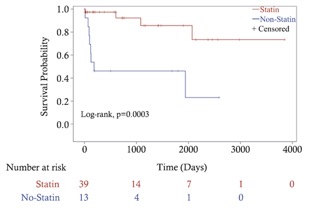Statins Improve Thrombosis Rates Of Cannulated Radiocephalic Av Fistulas In Diabetic Patients
Michael F. Amendola, MD, Dongjin Suh, Meg Reeves, Luke Wolfe, Marc Posner.
VA Medical Center/VCU Health System, Richmond, VA, USA.
INTRODUCTION: Radiocephalic arteriovenous fistula (RCAVF) creation is recommended by the NKF as the preferred first line hemodialysis access procedure. Analysis of diabetic rat arteriovenous fistula model indicates improved vascular function with HMG-CoA-Reductase Inhibitor (statin) use. We predict similar outcomes in diabetic patients undergoing primary RCAVF placement.
METHODS: A Veterans Administration Hospital dialysis access database over a fifteen-year period was accessed identifying all RCAVF placements in diabetic patients. Patients were stratified into statin medication usage or not at RCAVF creation. Outcomes examined include rate of successful cannulation, functional patency duration, interventions per access, and rates of access thrombosis.
RESULTS: Total number of 123 RCAVF cases were performed in 122 diabetic male patients. At the time of RCAVF placement, 92 cases were performed on patients that were taking statin medication and 31 cases were performed on patients that were not taking statin medication. There was no difference in terms of rate of successful cannulation, functional patency duration, and number of interventions per access between the statin and non-statin groups. However, rate of RCAVF thrombosis once accessed was significantly lower in the statin group compared to the non-statin group (p=0.0005). Kaplan-Meier survival curve for each group were compared using log-rank test to reveal that diabetic patients who were on statin therapy at the time of operation had significantly higher access survival over time against thrombosis once it was cannulated for dialysis treatment compared to those who were not on statin therapy (p=0.0003).

CONCLUSIONS: Statins appear to have protective effect against RCAVF thrombosis as predicted in animal models for diabetic patients undergoing primary RCAVF placements. There were similar functional outcomes in terms of rate of successful cannulation, functional patency duration, and number of interventions per access. These data should encourage further investigation of statins and their role in hemodialysis access.
Back to 2020 ePosters
